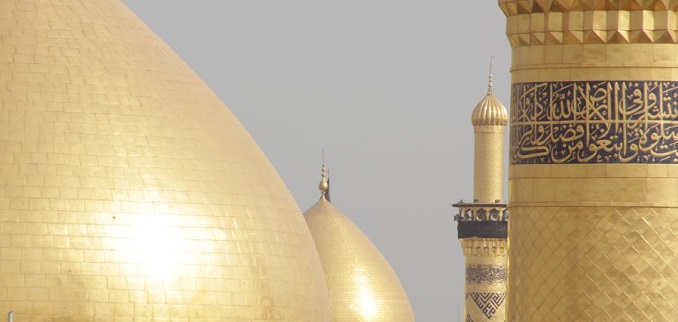
Buried within the Mosque
The grave of Hussein is found in the middle of the precinct, and is called the ‘Rawda’ or ‘Garden’ and it has several entry gates. The most famous one is called ‘Al-Qibla’ or ‘B?b al-Dhahab’. When it is entered, one can see the tomb of Habib ibn Madhahir al-Asadi, to the right hand side.
Habib was a friend and companion of Hussein since their childhood and was honored with martyrdom at the Battle of Karbala.
Within the shrine of Hussein can also be found a grave of all the 72 martyrs of Karbala. They were buried in a mass grave which was then covered with soil to the ground level. This mass grave is at the foot of Hussein’s grave. As well, beside Hussein’s grave are the graves of his two sons: ‘Ali al-Akbar and the 6-month old, ‘Ali al-Asghar. Also buried within the mosque is Ibrahim (son of the seventh Twelver Shi‘ah Imam, Musa al-Kadhim), who spent his life preaching about Karbala.
Martyrdom and popularity
Karbala was at first an uninhabited place and did not witness any constructional activity, although it was rich in water and its soil fertile.
From the time of Hussein ibn ‘Ali’s death in 680, pilgrimages to commemorate the massacre have often been repressed.
Despite many attempts by successive rulers, such as Al-Rashid and Al-Mutawakkil, to put a restriction on the development of this area, it has nonetheless spread with time to become a city.
Early development & specifications
The historian Ibn Kuluwayh mentioned that those who buried Hussein ibn ‘Ali, made a special and rigid construction with signs above the grave.
Higher and bigger constructions above the grave started during the ruling of al-Saffah, but heavy restrictions were put in place to prevent people from visiting the grave during the rule of Harun al-Rashid.
At the time of al-Ma'mun, construction around the grave resumed until the year 850, when al-Mutawakkil ordered the destruction and digging of the grave, and then filling the pit with water. His son who succeeded him al-Muntasir, allowed people to visit the grave site, and since then building the precinct to the grave increased and developed step by step.
On the other hand, the historian Ibn al-Athir stated that in the year 371 AH, ‘Adhud ad-Dawlah became the first to largely lay the foundations for large scale construction, and generously decorated the place. He also built houses and markets around the precinct, and surrounded Karbala with a high boundary wall turning it into a strong castle.
In the year 407 AH, the precinct caught fire due to the dropping of two large candles on the wooden decorations. The state minister at the time, Hassan ibn Fadl, rebuilt the damaged sections.
History has recorded the names of several rulers who shared the honor of widening, decorating or keeping the precinct in good condition. Amongst them is Fat'h ‘Ali Shah Qajar, who in 1250 AH ordered the construction of two domes, one over Hussein ibn ‘Ali’s grave and the other over his brother ‘Abbas ibn ‘Ali.
The first dome is 27 meters high and completely covered with gold. At the bottom, it is surrounded with 12 windows, each of which is about 1.25 m away from the other, from the inside, and 1.30 m from the outside.
The mausoleum has an area of 59 m / 75 m with ten gates, and about 65 rooms, well decorated from the inside and outside, used as classrooms for studying.
Last modified on Saturday, 27 June 2015 14:05
